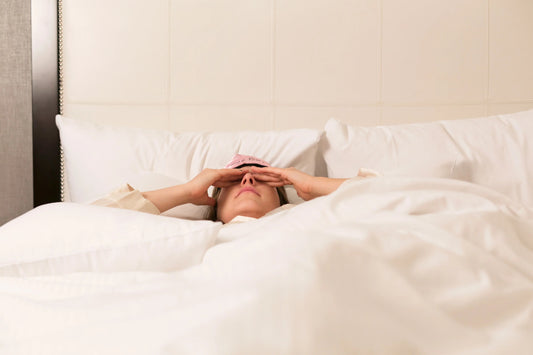Creating the Perfect Sleep Sanctuary
By Cam Hayes
RedFIN Content Team and RENT Blog
https://www.rent.com/blog/sleep-sanctuary/
Transforming your bedroom into a sleep sanctuary can significantly enhance your rest and rejuvenation. A well-designed sleep space not only promotes relaxation but also helps you wake up feeling refreshed and ready to tackle the day. So whether you are upgrading your rental house in Little Rock, revamping your apartment in Portland, or renovating your home in Colorado Springs, here are some essential tips to create your ultimate sleep haven.

Creating the perfect sleep sanctuary: getting started
While the most comfortable sleeping arrangement will vary by individual, there are some standard practices that can set you on your way to creating a great environment for a good night’s sleep. Stephanie from International Down and Feather Bureau shared some great tips to outfit your space for comfortable and restful slumber:
“Creating the perfect sleep environment starts with making your bedroom your happy place. Start by adding cozy down pillows and comforters that not only feel great but also help regulate your temperature. A fluffy sleep mask ensures a calm, dark space, and a fan or earplugs can help block out unwanted sounds. Keeping your bedroom clean and clutter-free makes it a peaceful, inviting retreat where you can truly relax and recharge.”
In addition, Dr. Funke Afolabi-Brown from Restful Sleep MD shared expert insight about great ways to optimize your environment for sleep:
“To create an optimal sleeping environment, start with a high-quality mattress that provides a good spine alignment. Use breathable, natural bedding material and keep your bedroom cool, dark, and quiet. You can achieve this by maintaining a bedroom temperature between 65 and 72 degrees, investing in black-out shades or curtains, as well as using a white noise machine if needed. Opt for warm, dim lighting in the evening, as this can signal to your body that it is time to wind down.”

Find more information on these tips, as well as additional must-try suggestions from our experts below.
Maintain a clean bedroom
A clean bedroom is crucial for a restful environment. Dust and allergens can disrupt your sleep quality, so it’s important to establish a regular cleaning routine. Robin Murphy from ChirpChirp Cleaning provided some great cleaning tips to aid in maintaining a clean bedroom:
“We’re big believers in the power of a fresh, clean space for the best night’s sleep.
- Change your linens regularly — there’s nothing quite like sliding into crisp, clean sheets! Regularly changing your linens promotes better hygiene, helps prevent allergens, and can even improve your skin health.
- It’s important to keep your bedroom well dusted. Dust can carry allergens, irritate your airways, and disturb your sleep. A dust-free room not only keeps the air cleaner but also creates a calmer, more serene environment that’s perfect for rest.”
A tidy space fosters a sense of calm and order, setting the stage for better sleep. So make a regular cleaning routine to ensure that you don’t miss a wink!

Decluttering and organizing techniques
Clutter can be a significant source of stress and distraction and make it tough for our minds to rest when bedtime rolls around. Begin by evaluating what you truly need in your bedroom. Start with one area at a time, and “reduce clutter by donating, selling, or throwing away anything you no longer need, use or want. Implement organization systems that make it easy for you to keep your room clean and tidy,” suggests the team at Ducks in a Row Home Organization.
If you’re looking for organization systems to implement in your home, Hester Van Hien, home decluttering and organizing consultant at Tidylicious, has got you covered with the following recommendation:
“When we’re surrounded by too many things, our brains can be very busy registering everything around us, making us feel distracted, irritable and anxious, and none of this will aid your sleep. The KonMari Method®, developed by Japanese tidying expert Marie Kondo, is a methodical and effective approach that gives long-lasting results, and it’s all about tidying by category.
Start with your wardrobe, then move onto books, followed by paperwork, after that it’s everything else such as decorative items, medication, jewelry, bath and shower products, and spare change, and you finish with sentimental items. When using this method, try to focus on what you’d like to keep rather than what to discard. This usually makes the decluttering process much easier.”
At Rent., we also recommend the use of organizers, bins, and baskets to keep belongings neat and accessible. Designate specific places for essential items, which will help you maintain organization over time.

Bedding material for your sleep sanctuary
Your choice of bedding material significantly affects your sleep quality. Opt for breathable fabrics that help regulate temperature and wick away moisture. “I cannot recommend hemp bedding enough, it’s my go-to,” shares Danni Sinclair, holistic interior designer and founder of My Peace of Space.
“It’s a sustainable alternative to cotton linen. It’s a lot softer than linen and gets softer with each wash. It’s also moisture-wicking, and thermostatic, meaning it keeps you cool in the summer and warm in the winter. It’s the absolute best for maintaining a perfect sleep temperature.”
A comfortable hemp duvet or comforter, paired with soft, hypoallergenic pillows, will enhance your sleep experience. Remember to wash your bedding regularly to keep it fresh and inviting.

Mattress selection
Choosing the right mattress is one of the most critical factors in creating a sleep sanctuary. Your mattress should provide proper support and comfort tailored to your sleep position. Ryan Poppie, president and chief bedmaker at The Beloit Mattress, has some great tips for selecting the right mattress:
“The heart of an ideal sleep environment begins with the right mattress. Every body type and sleep position is unique, so finding a mattress that offers the right balance of support, pressure relief, and temperature regulation tailored to your specific needs is essential. No single mattress fits all, so selecting one based on your body type and sleep position is crucial for comfort and quality rest. Beyond the mattress, consider personal preferences. Creating the perfect bedroom environment is about understanding what makes you feel most comfortable.”
Whether you prefer memory foam, innerspring, or hybrid models, ensure it meets your individual needs. Don’t hesitate to test mattresses in-store and take advantage of sleep trials offered by many retailers.
Room temperature
Maintaining the ideal room temperature helps your body regulate its internal clock and promotes deeper sleep. Violet Giannone, founder and director of the Institute of Pediatric Sleep and Parenting advises that “To get the best rest, make sure the temperature in your bedroom is cozy — not too hot, not too cold — ideally between 65 and 68 degrees. If your sleep environment is too cold, this can lead to difficulty falling asleep, fragmented sleep, and lower sleep efficiency because your body will need to work harder to maintain its core temperature, disrupting your sleep cycle.
On the other hand, if it’s too warm, it can disrupt REM (rapid eye movement) sleep – the stage associated with dreaming and cognitive restoration. Studies have shown that high temperatures can cause restlessness, reduce REM sleep, and keep you awake longer.” Use fans, air conditioning, or heaters as needed, and consider investing in breathable bedding to help with temperature regulation.
Natural lighting solutions
Exposure to natural light plays a role in overall mental and physical health, and lighting control solutions can aid in optimizing this exposure in regards to sleep. Our lighting control expert Sofia De Vita from Cantifix shared that natural light has a direct, positive impact on vitamin D production, productivity and focus, circadian rhythm regulation, and psychological well-being, and shared some innovative glass solutions to optimize your exposure to natural light:
“At Cantifix, we focus on how our innovative glass solutions can enhance living spaces and improve overall well-being. Some of our standout products are:
Solstice glass is designed to harness the health benefits of natural light. This unique glazing allows for increased light transmission, optimizing blue light exposure, which helps regulate circadian rhythms and leads to better sleep and mood.
Switchable glass: This technology allows homeowners to control privacy and light levels at the touch of a button, ensuring that bedrooms are filled with natural light during the day while remaining dark at night for optimal sleep.
Heated glass: Our heated glass solutions provide additional comfort without relying on traditional heating systems that may disrupt sleep.”
Controlling light exposure is conducive to a sleep-friendly environment. Innovative glass solutions like the ones above can make controlling light a breeze and help minimize light and heat intrusion while maintaining an elegant aesthetic.
Nighttime lighting
Lighting plays a pivotal role in signaling your body that it’s time to wind down. The right lighting ambiance can make a huge difference when looking for ways to create the perfect sleep sanctuary, and Jim Luby from Oeo Energy Solutions has shared some amazing information to help you make the right choices:
“Creating the perfect sleeping environment has to do with more than the best bedding, the softest pillows, and bedtime routines. It’s also important to think about your nighttime lighting, and making an ambiance conducive to sleep. Consider the color temperature of your lighting, as rated on the Kelvin Scale.
Warm colors with hues of yellow and orange (or even amber) are better for preparing the mind and body for sleep than cooler colors. Look for nighttime lighting that is rated in the 2000K to 2200K range on the Kelvin scale, maybe even up to 2700K. Lighting that falls within higher ranges of the Kelvin scale, say 4000K or higher, is great for promoting alertness and productivity, but not ideal for sleep.”
Consider installing dimmable lights or using lamps with warm bulbs to create a calming atmosphere. Avoid bright overhead lights in the evening. Instead, opt for soft, ambient lighting that encourages relaxation. Smart bulbs can also be programmed to change intensity, helping you ease into sleep.
Head and neck alignment
From temperature to lighting, there are clearly many things that play a role in creating the perfect sleep sanctuary. Something else that should not be overlooked is proper body alignment. Aiden from Sleep Artisan recommends the following when looking to optimize your sleep environment with a focus on body alignment:
“We emphasize three key aspects of sleep/sleeping environment at Sleep Artisan: a proper sleeping temperature, a dark and quiet sleeping environment, and proper head, neck and spinal alignment (no matter the sleeping position). These three aspects of a perfect sleeping environment are enhanced with an adjustable pillow that suits each sleeper, no matter the sleeping position. Cool temperatures and a dark room make the perfect sleeping environment, and proper body alignment with a side sleeper promotes rejuvenating sleep and rids the body of sleep-related pain!”
Proper head, neck, and spinal alignment can dramatically improve not only your sleep quality but also your physical state during waking hours. Choose pillows that provide the right support based on your sleep position and invest in an adjustable pillow that can also help you find the perfect height and support for your neck.

Promote rest with darkness and calming scents
Darkness is crucial for regulating your circadian rhythm and essential oils like jasmine and bergamot are known for their calming properties which can aid in enhancing your sleep environment. Nathaniel Oliver from Type A Training: suggests that you “keep your room dark and quiet, and set a comfortable temperature to create a great place for sleep, helping your body recharge for the next day’s activities.” He also recommends using “calming smells like lavender or chamomile to help you relax and sleep better, aiding in muscle recovery and stress relief.”
Melissa Hellebuyck from Physalis also weighed in on the positive effects of calming scents on sleep, sharing that “Creating the perfect bedroom for sleep involves setting up a calming environment that promotes relaxation. Incorporating the right scents, like the Physalis Good Night synergy, can be a game-changer. This natural blend of essential oils is also available as an aroma spray — perfect for frequent travelers who want to recreate the same soothing scent of home in any bedroom. Simply diffuse or spray it before bedtime to enjoy a peaceful night’s rest.” Don’t overlook darkness and calming scents when creating the perfect sleep sanctuary, they could be the key to your sleep success!

Limit blue light and establish a routine
Blue light emitted from screens can interfere with melatonin production, making it harder to fall asleep. So while we know darkness is important for sleep, you should be mindful to refrain from leaving on bright lights and screens right until the moment you hop into bed. Aim to “avoid using digital devices, like your phone or tablet, at least one hour before bedtime. The blue light emitted by these screens mimics sunlight and can disrupt your circadian rhythm, making it harder to fall asleep.
Keep your phone on a charging station away from your bed to reduce temptation and improve sleep quality” shares Dr. Pam Theriot. She also notes that “Adults need 7 to 9 hours of sleep each night to allow the body to heal and rejuvenate. Aim to go to bed and wake up at the same time each day to support your natural circadian rhythm. Consistency is key to getting the restful sleep your body and eyes need.” For more tips and help creating a calming nightly routine, check out The Truth About Blue Light and Your Sleep.
Carla Butler from Ora Sleep Coaching also shared great insights on your sleep routine, noting that “A great night’s sleep starts in the morning. Set yourself up for success by spending 5-10 minutes outside in natural light as soon as possible after waking. Skip the sunglasses to ensure you get the full benefits of the morning light.” Carla also shared tips for initiating sleep onset for those struggling to fall asleep. “To create an optimal sleep environment, it’s essential that your brain associates the bed with sleep, not wakefulness.
If you’re struggling to fall asleep night after night, try my ‘circuit breaker.’ When you’ve been awake in bed for around 20 minutes, get up and engage in a relaxing (or even boring!) activity in dim lighting until you feel sleepy. This helps break the association between lying in bed and being awake, allowing you to fall asleep faster.”

Incorporate natural elements
One sleep-promoting solution that adds both aesthetic and functional characteristics to your sleep sanctuary is to incorporate natural elements like plants into your bedroom. The team at Grow Wild Studios shares their take on using plants to promote sleep:
“Curating the perfect bedroom for sleep involves creating a calming and serene environment. You can incorporate nature-inspired elements such as freshly cut flowers or potted plants to add a touch of color and life while contributing to cleaner air and a more relaxing atmosphere. Mindfully placed floral arrangements near the bed or on bedside tables can create a soothing visual focal point while strategically positioned house plants can improve air quality and introduce natural elements into the space.”
Improve air quality
Air quality plays a significant role in your sleep experience. Poor air quality can lead to sleep disturbances and negatively affect your physical function day-to-day. Heather Boyd, occupational therapist and podcast host at The Baby Sleep Connection has some great guidance for promoting healthy indoor air:
“When we’re looking to create a sleep sanctuary for ourselves, we often focus on what to put IN the room. But it’s just as valuable to consider what NOT to have in the room. Keeping a simple, sleep-focused, and healthy sleep environment means minimizing clutter, and also minimizing dust and pollutants. Our airways are vulnerable at night, and keeping dust and artificial scents out can mean a better night’s sleep. It’s also helpful to bring fresh air in when weather allows and to consider an air filter to help with air quality.”
You can also consider an air purifier to eliminate allergens and pollutants, and regularly ventilate your room by opening windows when possible.

Prioritize sleep in multi-functional spaces
Making sleep a priority is essential in today’s fast-paced world. If your sleeping area doubles as a workspace or entertainment area, Heather Boyd also has some great tips to help prioritize sleep when it’s time for bed:
“Our brains love consistency and patterns to fall asleep most easily, yet so often our bedrooms are multi-purpose: they double as work spaces for us, and play spaces for our children. This can make it hard to “turn our brains towards sleep”. If your bedroom doubles as your office, have a ‘work wind down’ ritual that involves closing your laptop and putting files away, out of sight. For children’s sleep spaces, keep a few books and a few simple, open-ended toys in a basket, but store noisy, battery-operated toys elsewhere, and keep lighting low during the bedtime routine.”
Set aside time each night for a consistent bedtime routine, signaling to your body that it’s time to wind down and avoid tasks such as work or intense exercise right before bed. Instead, engage in calming practices like reading or gentle stretching.
Creating the perfect sleep sanctuary: wrapping up
By implementing these tips and tricks, you can turn your bedroom into a sleep sanctuary that promotes relaxation and rejuvenation. Prioritizing a peaceful sleep environment can lead to improved sleep quality, better mood, more energized days, and enhanced overall well-being.








